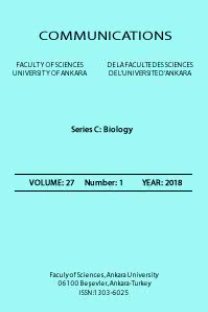CLASSIFICATION OF TURKISH HONEYS FROM AYDIN-KARACASU-DIKMEN VILLAGE BASED ON MELISSOPALYNOLOGICAL PARAMETERS
Honey, melissopalynology, blossom, honeydew
___
Sanz, M.L., Gonzalez, M., Lorenzo, C., Sanz, J., Castro, I, A contribution to the differentation between nectar honey and honeydew honey, Food Chemistry, 91 (2005), 313-317.Pȓidal, A, Vorlová, L, Honey and its physical parameters, Czech Journal of Animal Science, 47 (10) (2002), 439-444.
Der Ohe, W.V., Oddo, L.P., Piana, M.L., Morlot, M., Martin, P, Harmonized methods of melissopalynology, Apidologie, 35 (2004), 18-25.
Lazarević, K.B., Andrić, F., Trifković, Z., Milojković, D, Characterisation of Serbian unifloral honeys according to their physicochemical parameters, Food Chemistry, 132 (2012), 2060-2064.
Küçük, M., Kolaylı, S., Karaoğlu, Ş., Ulusoy, E., Baltacı, C, Candian, F, Biological activities and chemical composition of three honeys of different types from Anatolia. Food Chemistry, 100 (2007), 526-534.
Anklam, E, A review of the analytical methods to determine the geographical and botanical origin of honey, Food Chemistry, 63 (4) (1998), 549-562.
Soria, A.C., González, M., Lorenzo, C., Castro, I., Sanz, J, Characterization of artisanal honeys from Madrid (Central Spain) on the basis of their melissoplaynological, physicochemical and volatile composition data, Food Chemistry, 85 (2004), 121-130.
Bogdanov, S., Martin, P., Lüllmann, C, Harmonised methods of the European Honey Commission, Apidologie, extra issue, (1997), 1–59. Online: (http://www.apis.admin.ch/host/doc/pdfhoney/ IHCmethods_e.pdf) (accessed on 16 August 2004).
Bogdanov, S., Ruoff, K., Oddo, L.P., Physico-chemical methods for the characterisation of unifloral honeys: a review, Apidologie, 35 (2004), 4-17.
The Turkish Statistical Institute, 2018. www.tuik.gov.tr
Louveaux, J., Maurizio, A., Vorwohl, G, Methods of melissopalynology, Bee World, 59 (1978), 139-153.
Moar, N.T., Pollen analysis of New Zealand Honey, Journal of Agricultural Research, (1985), 28-38.
Maurizio, A., Microscopy of honey. – In: Honey: A comprehensive survey (ed. E. Crane), Heinemann, London. (1975), 240 – 257.
Canadian Food Inspection Agecy http://www.inspection.gc.ca/food/compliance-continuum/guidance-for-inspectors/sip/honey-inspection-procedures
Marcazzan, G.L., Caretta, C.M., Marchese, C.M., Piana, M.L., A review of methods for honey sensory analysis, Journal of Apicultural Research, 57(1) (2018), 75-87.
Kıvrak, Ş., Kıvrak, İ., Karbaba, E, Characterization of Turkish honeys regarding of physicochemical properties, and their adulteration analysis, Food Science and Technology, 37(1) (2017), 80-89
- ISSN: 1303-6025
- Yayın Aralığı: Yılda 2 Sayı
- Başlangıç: 1943
- Yayıncı: Ankara Üniversitesi
Mürşit Ömür KOYUNCU, Murat KÜTÜK
BIOFILM FORMATION AND CONTROL OF FACULTATIVE THERMOPHILE BREVIBACILLUS AGRI D505B
Tuğba KILIÇ, Arzu ÇÖLERİ CİHAN
Mustafa PEHLİVAN, Önder YUMRUTAŞ, İbrahim BOZGEYİK
REASSESSMENT OF IUCN THREAT CATEGORY FOR LOCAL ENDEMIC CAMPANULA DAMBOLDTIANA FROM ANKARA, TURKEY
Gül AYYILDIZ, Merve YILDIRIM, Ali Murat KESER, Ahmet Emre YAPRAK, Gül Nilhan TUĞ
Perinçek Seçkinozan ŞEKER, Ercüment ÇOLAK, Teoman KANKILIÇ, Engin SELVİ
DETERMINATION OF FUSARIUM SPECIES IN CARNATION GREENHOUSES IN ANTALYA, TURKEY
Aydin ATAKAN, Hülya ÖZGÖNEN ÖZKAYA
FLORA OF ÇALTEPE AND ÇELETEPE (BOLU)
NEMATODE-DESTROYING FUNGI: INFECTION STRUCTURES, INTERACTION MECHANISMS AND BIOCONTROL
Alexey YANCHUKOV, Andrei KANDAUROV, Mehmet Kürşat ŞAHİN, Ferhat MATUR
